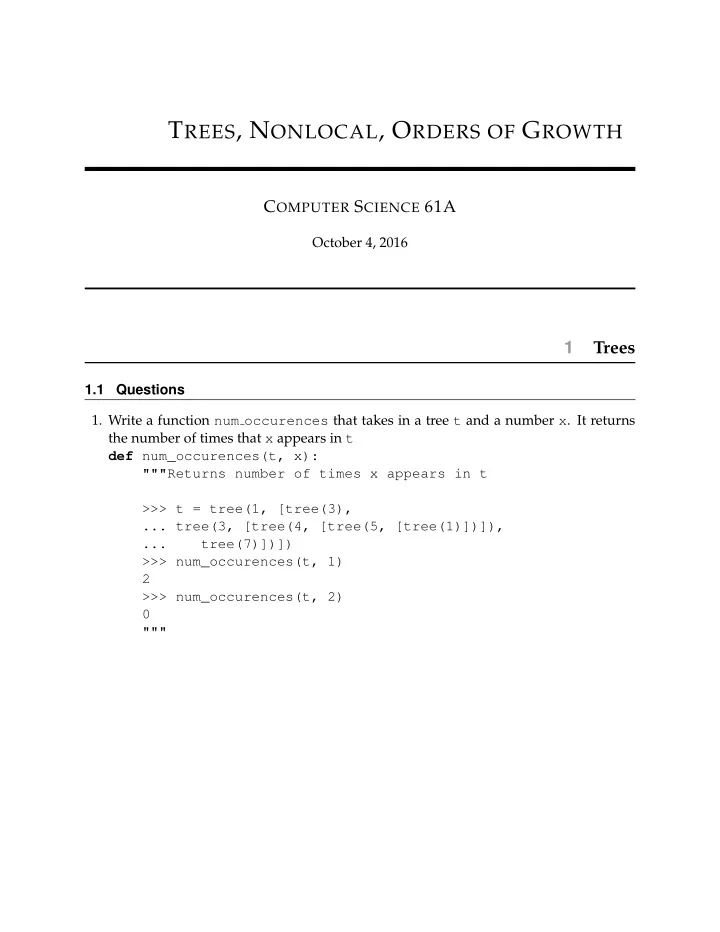

T REES , N ONLOCAL , O RDERS OF G ROWTH C OMPUTER S CIENCE 61A October 4, 2016 1 Trees 1.1 Questions 1. Write a function num occurences that takes in a tree t and a number x . It returns the number of times that x appears in t def num_occurences(t, x): """Returns number of times x appears in t >>> t = tree(1, [tree(3), ... tree(3, [tree(4, [tree(5, [tree(1)])]), ... tree(7)])]) >>> num_occurences(t, 1) 2 >>> num_occurences(t, 2) 0 """
D ISCUSSION : T REES , N ONLOCAL , O RDERS OF G ROWTH Page 2 2. Write a function has path that takes in a tree t and a string word . It returns True if there is a path that starts from the root where the entries along the path spell out the word, and False otherwise. def has_path(t, word): """Return whether there is a path in a tree where the entries along the path spell out a particular word. >>> greetings = tree('h', [tree('i'), ... tree('e', [tree('l', [tree('l', [tree('o')])]), ... tree('y')])]) >>> print_tree(greetings) h i e l l o y >>> has_path(greetings, 'h') True >>> has_path(greetings, 'i') False >>> has_path(greetings, 'hi') True >>> has_path(greetings, 'hello') True >>> has_path(greetings, 'hey') True >>> has_path(greetings, 'bye') False """ CS 61A Fall 2016
D ISCUSSION : T REES , N ONLOCAL , O RDERS OF G ROWTH Page 3 3. In the first week of class, we learned that expressions like mul(sub(4, 5), add(2, 3)) can be represented as expression trees. In this problem we use our tree abstract data structure to further explore this idea. Write a function evaluate , which takes a binary expression tree, exp and returns what that expression would evaluate to. You may assume that all operators will take exactly 2 arguments, and that nodes always have either 0 or 2 children (never 1). def evaluate(exp): """Evaluates exp, which is an expression tree. >>> from operator import add, sub, mul >>> exp = tree(3) # 3 >>> evaluate(exp) 3 >>> exp = tree(add, [tree(3), tree(4)]) # add(3, 4) >>> evaluate(exp) 7 >>> exp = tree(mul, [tree(add, [tree(3), tree(5)]), tree(sub, [tree(5), tree(2)])]) # mul(add(3, 5), sub(5, 2)) >>> evaluate(exp) 24 """ CS 61A Fall 2016
D ISCUSSION : T REES , N ONLOCAL , O RDERS OF G ROWTH Page 4 2 Nonlocal 2.1 Questions 1. Draw the environment diagram for the code below: def sum (lst): total = 0 def help (you): nonlocal total total += lst[you] lst[you] = total - lst[you] me = 0 while me < len (lst): help (me) me += 1 return total a = sum ([6, 1]) CS 61A Fall 2016
D ISCUSSION : T REES , N ONLOCAL , O RDERS OF G ROWTH Page 5 2. Draw the environment diagram for the code below: breakfast = 'waffles' def saturday(morning): def breakfast(cereal): nonlocal breakfast breakfast = cereal breakfast(morning) return breakfast saturday( lambda morning: breakfast)('cereal') CS 61A Fall 2016
D ISCUSSION : T REES , N ONLOCAL , O RDERS OF G ROWTH Page 6 3 Orders of Growth 3.1 Questions 1. What is the order of growth for a call to fizzle(n) ? def fizzle(n): if n <= 0: return n elif n % 23 == 0: return n return fizzle(n - 1) 2. What is the order of growth for a call to explode(n) ? def boom(n): if n == 0: return "BOOM!" return boom(n - 1) def explode(n): if n == 0: return boom(n) i = 0 while i < n: boom(n) i += 1 return boom(n) 3. What is the order of growth for a call to dreams(n) ? def dreams(n): if n <= 0: return n if n > 0: return n + dreams(n // 2) CS 61A Fall 2016
Recommend
More recommend